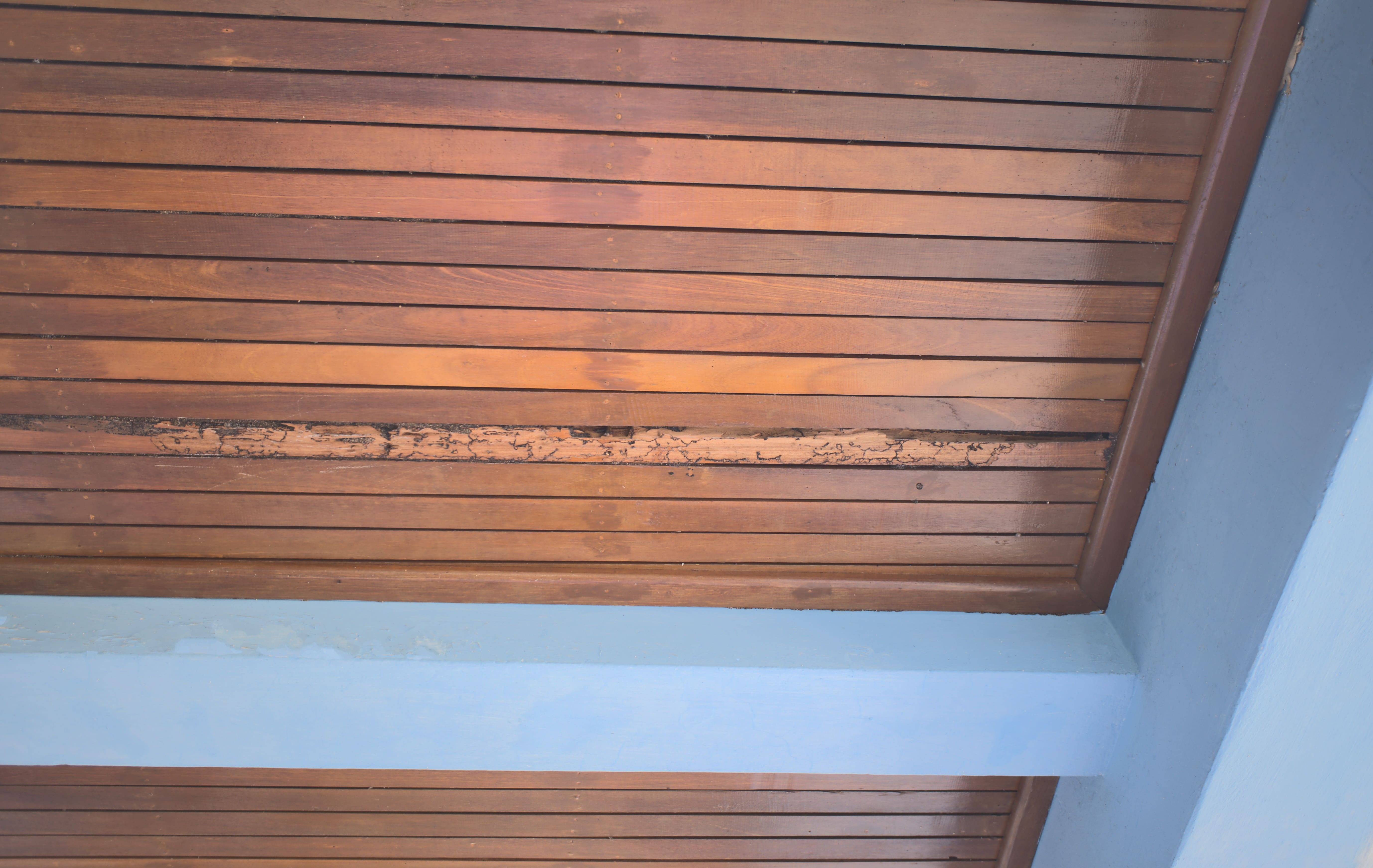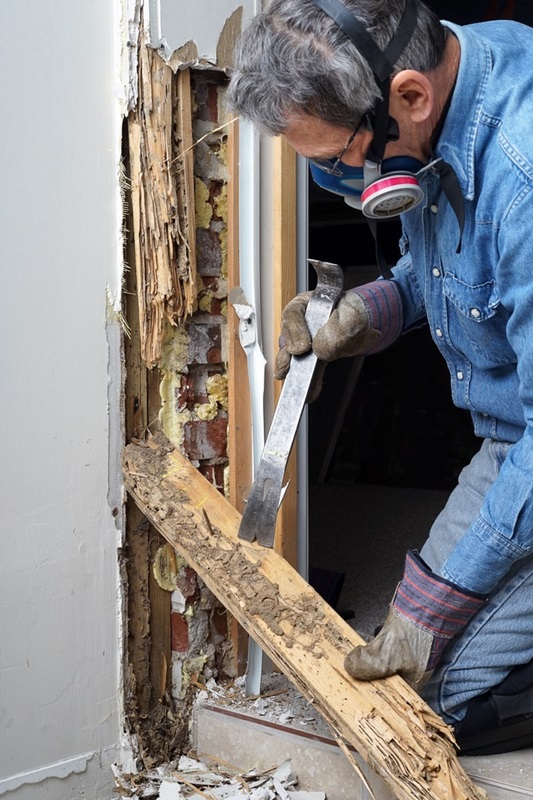Contributed by: Doug Webb
Updated on: November 4, 2022
Termites are responsible for billions of dollars in damages to U.S. homes each year. It's important for homeowners to know the signs of termites that can indicate an infestation. But what do you do if you see evidence of termite damage in your home?
Learn when you should hold off on do-it-yourself fixes and why, so you can avoid the inconvenience of repairing termite damage only to find out you haven't fully addressed the problem.
Termite damage in ceilings
Like any wooden structure in your home, your roof can be vulnerable to damage from termites in the ceiling. Both subterranean and drywood termites can pose a threat to the integrity of your roof, inhabiting areas of your ceiling, including around fireplaces where leaks may have occurred and over bathrooms where excessive moisture may be trapped underneath the insulation.

Drywood termites live and feed inside wood. They can establish colonies inside ceiling rafters, roof beams, eaves and other wooden structures associated with your roof. Drywood termites can even establish colonies underneath wood shingles.
Related: How to spot termites
Unlike drywood termites, subterranean termites typically build their colonies in the soil in an area where they have access to wood. Dampness provides a more conducive environment for infestation, but is not required since they get the moisture they need from the soil they are nesting in. All they really need is a way inside your house.
Termite damage in sheetrock or drywall
Termites feed on cellulose, a naturally occurring substance that gives plants their rigid structure. Their bodies contain bacteria with special enzymes that help them convert the cellulose to the nutrients they need to survive.

When it comes to sources of cellulose, termites don't discriminate – they'll eat virtually anything that contains it. Surprisingly, that includes drywall, also know as sheetrock. Drywall is composed of plaster panels covered in paper, which contains cellulose. It's this paper that makes the drywall in your home a target for termites.

What does termite damage look like in ceilings, drywall and sheetrock?
While you should rely on a trained professional to inspect and treat any possible termite-in-ceiling infestations in your home, you can look for the following warning signs of termite ceiling and drywall damage:
- Bubbling and discoloration similar to water damage on your ceilings
- Any areas of buckling or sagging in your ceilings
- Cracks in your ceilings, due to an infestation of termites in structural beams
- Mud tubes that extend toward your ceilings
- "Drop tubes" coming out of ceilings, in which a small tube 3-4 inches long comes directly out of the ceiling in the middle of the room.
Termite damage repair
The unfortunate truth is that termites are a serious problem, whether they're dining on wood or sheet rock. Termite infestations can go undetected for long periods of time, creating even more damage. As a homeowner, it's imperative that you take immediate action if you notice signs of termites in your home.
Termites can damage wooden baseboards and drywall. Even more concerning, though, is the fact that they can damage the structural supports of your home. Termites may compromise wooden joists that support load-bearing walls, which are essential to the structural integrity of your house. Often, repairing this type of damage comes with a high price tag.
Most insurance policies do not cover termite damage because insurance companies consider it preventable. If your policy does not cover termites and your house has structural damage as a result of these pests, you can expect to pay a significant amount of money to repair these damages.
Termite damage repair in sheetrock
A termite control professional can determine if termites have been eating your sheetrock or have caused significant damage to the sheetrock in the past. They look for trails that termites leave inside the sheetrock, or small pinholes that termites sometimes make in sheetrock.
Sheetrock can usually be replaced by removing the sections that are damaged and replacing it with new sections after your home has been treated for termites and the infestation has been eliminated. However, if termites were eating your sheetrock, they may also have been chewing on nearby wall studs and ceiling joists. Those may be more difficult to repair.
When is it OK to start repairing termite-damaged wood?
Before attempting any DIY repair instructions for termite wood damage, you should consult a termite control professional. This way, you can have a trained technician inspect your home for termites to determine the extent of the damage.
After all, you don't want to spend your time, energy and money restoring parts of your home only to find out you have a major infestation that will result in having to make the same repairs again. Each year in the U.S., termites costs homeowners an estimated $5 billion in damage and repair costs.
Termite damage prevention
The best way to avoid the costly treatments and repairs associated with termites is to take preventive action. You can take the following preventative measures to help protect your ceiling and drywall and the rest of your home from termite damage:
- Paint, stain, seal or otherwise treat any exposed wood on your home's exterior.
- If you are aware of any roof leaks or other damage to your shingles, fascia boards or eaves, conduct repairs immediately.
- Have any plumbing leaks underneath your home repaired immediately. Do not allow water to collect underneath your home.
- Keep your gutters clear of debris to allow for proper drainage.
- Make sure your home's entire attic and foundation vents are properly screened.
- Do not allow wood debris to accumulate near your home.
- Trim any vegetation, such as shrubs, surrounding your home. Do not allow vegetation to become so overgrown that it traps moisture around your foundation or blocks foundation vents. Cut back any tree limbs that are resting on your roof or touching wooden structures such as eaves or window framing.
- Avoid the use of mulch close to your home, especially if you have wooden siding.
- Take any of the above warning signs seriously, and do not put off contacting a trained pest control technician or agency to get a professional opinion if you find any termite ceiling damage.
When should you call a termite control professional?
If you spot signs of termite damage in your home, you should definitely call a professional termite control company as soon as possible. Keep in mind, though, just because you don't see signs of damage does not mean that you don't have termites in your house. In fact, a termite colony is capable of silently causing damage to your home before leaving behind any visible signs.
Therefore, it's a good idea to be proactive and make sure that you have a termite prevention plan with annual inspections in place. Regular termite inspections can increase the odds of discovering these insects in your home before they've caused extensive damage.



